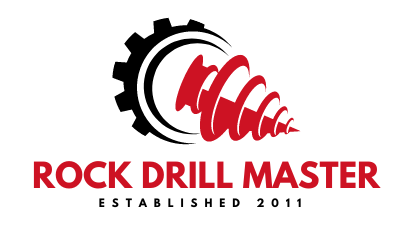When it comes to drilling through rock efficiently, Down-The-Hole (DTH) drill bits are the go-to tools for many industries. In this ultimate guide, we’ll break down what DTH drill bits are, explore the different types of bit designs, and discuss their common applications. By the end, you’ll understand how choosing the right type of DTH bit can make all the difference in drilling performance.
(Best Practices for Maintaining DTH Drill Bits) Multiple DTH drill bits (blue) ready for use, illustrating the variety of sizes and designs available in the market.
What Are DTH Drill Bits and How Do They Work?
DTH drill bits are specialized cutting tools used in down-the-hole drilling rigs. Unlike regular drill bits attached to a surface hammer, a DTH bit is attached to a pneumatic hammer that operates at the bottom of the borehole. This hammer strikes the bit directly from behind, breaking the rock, while the drill rig’s rotation and thrust advance the bit forward (Down-the-hole drill – Wikipedia) (Down-the-hole drill – Wikipedia). Compressed air is typically used to power the hammer and flush out rock cuttings through holes in the bit face.
Key characteristics of DTH bits include:
- Tungsten Carbide Buttons: These are the hard, bullet-shaped or spherical inserts on the bit’s face that crush and cut the rock.
- Flushing Holes: Openings in the bit face allow air (or fluid) to carry debris out of the hole, keeping the cutting surface clear.
- Shank: The back end of the bit has a specific shape (spline) that locks into the DTH hammer. The shank type must match the hammer model.
Because the percussion happens down in the hole (right behind the bit), DTH drilling maintains high impact energy even as the hole gets deeper. This results in fast drilling speeds and straight boreholes (minimal deviation), which is crucial in many applications.
Types of DTH Drill Bits
DTH drill bits come in various designs to handle different rock conditions. The two primary aspects of a bit’s design are its face shape and carbide insert shape. Each combination is suited for specific ground conditions and drilling goals.
- Face Design: The configuration of the bit’s front surface (flat, convex, concave, etc.) affects how it drills:
- Flat Face – A flat front is a general-purpose design. It excels in hard, abrasive rock, providing stability and even button wear. However, in very soft ground it may “over-drill” (go too fast) (DTH Drill Bits – Mincon).
- Convex Face – A domed or protruding face focuses impact energy to the center. Convex bits drill straighter holes and often have high penetration rates in medium to hard rock (DTH Bits – Rock Drilling Tools – Ocma) (DTH Bits – Rock Drilling Tools – Ocma). They also handle abrasive formations well.
- Concave Face – A concave (dished) face has a central dip. This helps center the bit in the hole, great for keeping holes straight in variable or soft rock (DTH Drill Bits – Mincon). It’s a good all-round design for both hard and soft formations.
- Drop Center – A variant of concave with a sharper drop in the middle. It’s used to aggressively center the bit and increase penetration in softer rock (Exploring Face Designs of DTH Drill Bits for Optimal Drilling).
- Double Gauge / Stepped – This design includes a second row of gauge buttons or a step, giving extra hole wall support. It’s used in extremely hard or abrasive rock to maintain hole diameter and protect the bit body (Exploring Face Designs of DTH Drill Bits for Optimal Drilling).
- Dome / Convex Dome – A smoothly domed face distributes stress uniformly. It’s often chosen for very deep holes or high-stress conditions because it reduces the risk of bit fractures (Exploring Face Designs of DTH Drill Bits for Optimal Drilling).
- Carbide Insert Shape: The tungsten carbide buttons come mainly in three shapes:
- Spherical (Domed) – Rounded inserts that are very tough. Best for hard, abrasive rock where durability is needed (DTH Drill Bits – Mincon). They sacrifice a bit of speed but resist breakage and wear.
- Ballistic (Pointed) – Sharply pointed inserts that penetrate faster in softer or less abrasive rock (DTH Drill Bits – Mincon). They drill quickly but can chip or wear in hard rock.
- Semi-Ballistic – A hybrid between the two: partly rounded tip. They offer a balance – more speed than spherical and more strength than full ballistic (DTH Drill Bits – Mincon). Useful for medium-hard conditions.
Table: Common DTH Bit Face Designs and Their Best Uses
| Bit Face Design | Description & Best Applications |
| Flat | Flat front for stability. Ideal for hard, abrasive rock; resists wear, keeps straight holes. Not suited for soft ground (may drill too fast). |
| Convex | Curved outward (domed). Good all-purpose, shines in medium to hard rock. Drills straight holes with high penetration. Handles abrasiveness well. |
| Concave | Curved inward (dished). Self-centering in hole – great for keeping straight in softer or mixed formations. Versatile across hard and soft rock. |
| Drop Center | Deep concave center. Increases bite in soft to medium rock, improving penetration. Keeps hole straight; good when extra centering force needed. |
| Double Gauge | Extended gauge section (often two-step). Designed for extremely hard/abrasive rock. Extra side support prevents wear on bit body (“body wash”). |
| Dome | Fully rounded crown. Distributes impact evenly. Used for very deep or high-stress drilling to avoid cracking bit; lower risk of failure under stress. |
(Understanding DTH Drill Bit Sizes and Applications) Close-up of an orange-painted DTH drill bit. Note the tungsten carbide buttons on the face and the two large flushing holes for removing cuttings.
In practice, manufacturers combine these design elements to create bits for every scenario. For example, a “hard rock bit” might be flat-faced with spherical buttons to maximize durability, whereas a “fast penetration bit” for softer ground might be concave with ballistic buttons for speed.
Applications of DTH Drill Bits
One reason DTH drilling is so popular is its versatility. DTH drill bits are used in a wide range of drilling applications where straight, clean holes are required in rock or hard ground. Here are some major areas and how DTH bits excel in each:
- Mining and Quarrying: In open-pit mines and quarries, DTH bits are commonly used to drill blastholes for explosives. Hole diameters might range from 90mm up to 254mm (3.5 to 10 inches) or more. DTH drilling in mining ensures holes are straight and correctly placed for controlled blasting. The ability to maintain fast penetration in hard rock makes DTH ideal for drilling benches in iron ore, copper, aggregates, etc. It’s especially favored for deeper holes where top-hammer drills would lose energy.
- Construction (Foundation Piles and Rock Anchors): Construction projects often require drilling into rock for foundations (piling) or anchoring supports. DTH bits can drill straight, vertical shafts through soil and rock for cast-in-place concrete piles or for installing rock anchors (Applications of DTH Drill Bits in Construction-Kelleg) (Applications of DTH Drill Bits in Construction-Kelleg). Their precision minimizes deviation, which is critical when multiple piles/anchors must align. DTH is also used for tunneling (drilling probe holes, drain holes, or blasting holes for tunnel excavation) (Applications of DTH Drill Bits in Construction-Kelleg) and for drilling grout holes in dams or tunnel linings.
- Water Well and Geothermal Drilling: DTH drilling is a popular method for water wells, especially medium to deep wells in hard formations. Typically starting in softer overburden with another method, once rock is encountered a DTH hammer with the appropriate bit can rapidly drill the borehole while keeping it straight. The straightness is vital to successfully install well casing and keep the hole open. Similarly, for geothermal boreholes (which can be hundreds of meters deep), DTH bits offer a good balance of speed and directional accuracy in rock.
- Exploration and Sampling: In mineral exploration, reverse-circulation (RC) DTH bits are often used. These are special DTH bits with an inner passage that allows rock cuttings to be transported up inside the drill string (kept separate from the hole walls). They enable collecting samples of the rock as the bit drills through it. This is common in gold or other metal exploration; the RC DTH method provides high-quality samples from known depths.
- Infrastructure and Other Uses: DTH drill bits are also found in applications like micro-piling for building reinforcements, slope stabilization (drilling holes for rock bolts on unstable slopes), marine construction (drilling into seabed rock for piers), and even specialty uses like drilling blast holes for demolition in urban sites where precision is crucial.
(Drilling Rig Mining Photos, Download The BEST Free Drilling Rig Mining Stock Photos & HD Images) A crawler drill rig using a DTH hammer to create boreholes at a construction site. DTH drilling excels in such applications by rapidly penetrating rock while keeping holes true to line.
Each application might favor different types of DTH bits. For instance, drilling in a broken, fractured rock at a construction site might call for a concave bit to stay on course, whereas drilling a deep water well in homogeneous granite may use a flat or convex bit for durability.
Maximizing Performance with the Right Bit
Understanding the types of DTH drill bits and their intended applications is the first step to a successful drilling project. By selecting a bit design that matches your rock conditions and project goals, you ensure faster drilling, longer bit life, and ultimately lower cost per meter drilled. Always consult with bit manufacturers or experienced drilling engineers if unsure – using this guide as a starting point, you’ll be well on your way to choosing the perfect DTH bit for any job.






